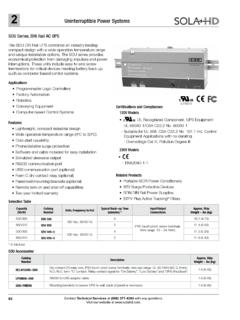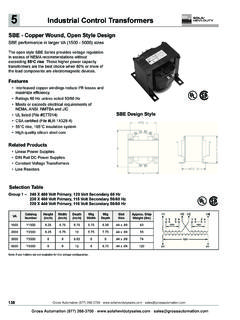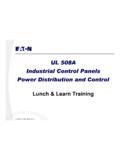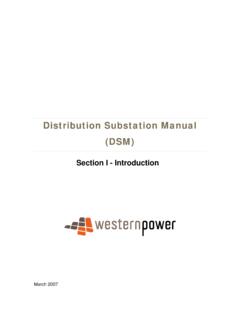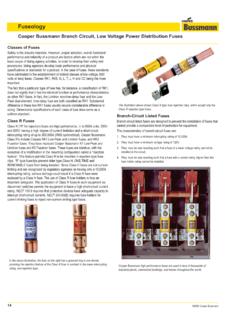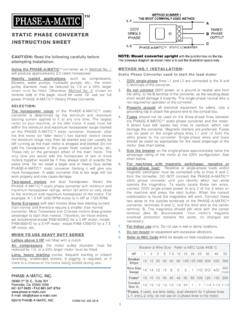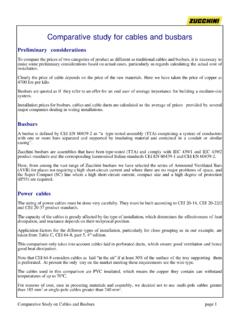Transcription of Selection Steps - Sola/Hevi-Duty Products
1 Transformers6150 Visit our website at or contact Technical Services at (800) 377-4384 with any questions. 3. If the load is expressed in wattage, either utilize the formula below to convert to kVA or refer to the equipment nameplate to obtain amperage requirement. 4. If the load is a motor and expressed in horse pow er, refer to the motor horsepower charts on the next sizes may require an optional weather shield (order separately) for outdoor size the transformer to the load requirements. kVA (1 ) =Volts x Amps1000kVA (3 ) =Volts x Amps x ti fi edList edSelection StepsA. An online transformer product selector is available in the Transformer section of our website or you can use the following Steps below to manually select a trans form Find the elec tri cal load re quire ments.
2 These are:1. Load operating Load frequency (ex pressed in Hz).3. Determine load size - usually expressed in kVA, amperage or Is the load designed to operate on single phase or three phase power?This information is available from the equipment manufacturer and is typically listed on the nameplate of the equip Know the supply voltage con di tions:1. Available source Available source fre quen cy (a transformer will not change frequency. The frequency of the supply voltage and the needed load voltage must be equal).3. Number of phases on power Determine the transformer kVA rating:1. If the load is expressed in kVA, select the appropriate transformer from the following Selection charts (make sure the selected transformer s kVA rating is equal to or greater than the required load kVA).
3 2. If the load is expressed in amperage, use either the appropriate kVA formula listed below or the appropriate sizing chart on the next =Wattage(1000 x Power Factor of the load)E25872E77014 Transformers6151 Visit our website at or contact Technical Services at (800) 377-4384 with any ques Motor horsepower charts are based on 1800 RPM squirrel cage induction motors. If using another type of motor, check running amperage against the chart and adjust as nec es Increase required trans form er kVA by 20% if motors are started more than once per If your motor service factor is greater than 1, pro por tion al ly increase full load am per age. ( if service factor is , increase full load am per age by 10%).
4 Are there any special application considerations?A. For am bi ent con di tions over 40 C, derate the trans form er nameplate kVA by 8% for each 10 C above 40 For high altitude ap pli ca tions, derate the transformer nameplate kVA by for every 330 feet over 3300 feet above sea level. This assures proper trans form er convection Some applications may require a transformer design that limits the BTU output of the unit at full load or a design to withstand and mitigate specifi c electrical anomalies. Single Phase: Full Load Current ChartThree Phase: Full Load Current ChartThree Phase Motor Chart:AC, Motor Horsepower AmperageSingle Phase Motor Chart: AC, Motor Horsepower AmperageThree things to keep in mind:kVA Rating120 V208 V240 V277 V480 V600 Rating208 V240 V480 V600 Power115 V208 V230 V460 V575 VMini Tfmr.
5 KVAStd. NEMA kVA Size1 1 Power208 V230 V460 V575 VMini NEMAkVASize our website at or contact Technical Services at (800) 377-4384 with any ProtectionFusing and circuit breaker protection. How to overcurrent protect 600 Volt class transformers and associated wiring per NEC 450-3(b) and NEC Primary protection only is required if the transformer is single-phase and the secondary has only two wires. Overcurrent protection rating and location are shown in Diagram A2. If the branch circuit feeding the transformer has overcurrent protection to meet the individual protection requirements in Example 1, then individual transformer protection is not B3. Primary and secondary protection is required if the transformer has more than two wires on the secondary C4.
6 If the branch circuit feeding the transformer has overcurrent protection to meet the individual primary overcurrent protection requirements in Example 3, then individual primary protection is not required. Secondary OCP is required as shown DPrimary CurrentOvercurrent Protection RatingLess than 2 amps 300% maximum2 to 9 amps 167% maximum9 amps or more 125% of rated primary current (or next highest standard rating)Primary CurrentOvercurrent Protection RatingLess than 2 amps300% maximum2 to 9 amps167% maximum9 amps or more125% of rated primary current (or next highest standard rating)Primary CurrentSecondary CurrentOvercurrent Protection Rating250% primary currentLess than 9 amps 167% maximumNot more than 250%9 amps or more 125% (or next higher standard rating)
7 Primary CurrentSecondary CurrentOvercurrent Protection Rating250% primary currentLess than 9 amps 167% maximumNot more than 250%9 amps or more 125% (or next higher standard rating) Section (a) of the 2005 National Electrical Code*The standard ampere ratings for fuses and inverse time circuit breakers shall be considered 15, 20, 25, 30, 35, 40, 45, 50, 60, 70, 80, 90, 100, 110, 125, 150, 175, 200, 225, 250, 300, 350, 400, 450, 500, 600, 700, 800, 1000, 1200, 1600, 2000, 2500, 3000, 4000, 5000 and 6000 amperes. Additional standard ratings for fuses shall be considered 1, 3, 6, 10 and 601. The use of fuses and inverse time circuit breakers with nonstandard ampere ratings shall be permitted.* Reprinted with permission from NFPA 70-2005, National Electri-cal Code , 2005, National Fire Protection As so ci a tion, Quincy, MA 02269.
8 This reprinted material is not the com plete and offi cial position of the NFPA on the ref er enced subject which is represented only by the standard in its our website at or contact Technical Services at (800) 377-4384 with any ques = I*125% next size higher if primary current is 9 amp. or higher. No secondary fusing required.( fuse ) = (I*250%) next size smaller if primary current is 9 Amps. or higher. Secondary fusing is required see chart for = I*167% next size smaller if primary current is less than 9 amp. No secondary fusing required.( fuse ) = (I*250%) next size smaller if primary current is less than 9 Amps. and secondary fusing is required see chart for = I*300% next size smaller if primary current is less than 2 amp.
9 No secondary fusing required.( fuse ) = (I*500%) next size smaller if used for a motor control circuit per NEC 430-72[C] exception No. 4 Primary fuse Recommendations Recommended fuse sizes per UL 508 and NEC450-3 (B) (1), NED 430-72 and commercially available type (2).75 ( ).6 ( ).6 ( ).6 (1).6 (1).5 (.8).3 (.5).3 (.5).3 (.5).25 (.4).25 (.4).25 (.4) (3) ( )1 ( )1 ( ).8 ( ).8 ( ).8 ( ).5 (.8).4 (.8).4 (.75).4 (.6).3 (.6).3 (.6) (4) ( ) ( ) ( ) (2) (2)1 ( ).6 ( ).6 (1).6 (1).5 (.8).5 (.8).5 (.8) ( ) ( )2 ( )2 ( ) ( ) (3) ( )1 ( ).8 ( ).8 ( ).8 ( ).75 ( ).75 ( )2005 (8)3 (5) ( ) ( ) (4) (4)2 ( ) ( ) (2) (2)1 ( )1 ( )1 ( )2503 (5) ( ) (6) ( ) (5)3 (5) ( ) ( ) ( ) ( ) ( ) (2) (2)3004 ( ) ( )4 (7)4 ( ) ( ) ( ) (5)2 ( ) ( ) (3) ( ) ( ) ( ) (7)5 (8)5 (8) ( ) ( )4 (7) ( ) ( ) ( )2 ( ) (3) (3) ( ) (10)4 ( )4 (6) ( ) (5)3 (5)5 (9) ( ) (5)3 (5) ( ) (4) (4)75010 (15) (9)6 (9) (8)5 (8)5 ( )8 (12)5 (8) (8) ( )4 ( ) ( ) ( )100012 (20)8 (12)8 (12) (10)7 (10) (10)10 ( ) ( ) (5)3 (5)5 (9)5 (8)5 (8) (30)12 (15)12 (15)10 (15)10 (15)10 (15)15 (25) (8)5 (8)5 ( ) ( ) ( ) ( )200025 (40)15 (25)15 (20)15 (20)12 (20)12 (20)20 (35) (10)7 (10) (10)6 (9) (8)5 (8)300035 (60)20 (35)20 (35) (30) (30)20 (30)35 (50)10 (15)10 (15)10 (15)
10 9 (12)8 (12)8 (12)500060 (100)35 (60)30 (60)30 (50)30 (50)30 (50)60 (90)15 (25)15 (25)15 (25)12 (20)12 (20)12 (20)750080 (150)50 (90)45 (90)45 (80)45 (80)40 (70)90 (125)25 (40)25 (40)20 (35)20 (30)10K110 (200)70 (125)60 (110)60 (110)60 (110)60 (100)110 (175)30 (50)30 (50)30 (50)25 (45)15K175 (300)100 (175)90 (175)90 (150)90 (150)80 (150)175 (250)45 (80)45 (80)40 (70)35 (60)25K300 (500)175 (300) 150 (300)150 (250)150 (250) 150 (250)90 (250)60 (70)70 (125)70 (125)60 (110)37K200 (350)100 (175)80 (150)50K300 (500)150 (250)110 (200)75K400 (750)200 (350)175 (300)100K600 (1000)300 (500)225 (400)167K900 (1600)450 (850)350 (650)Transformers6154 Visit our website at or contact Technical Services at (800) 377-4384 with any Overcurrent ProtectionA transformer has all the same component parts as a motor, and like a motor, exhibits an inrush when energized.




